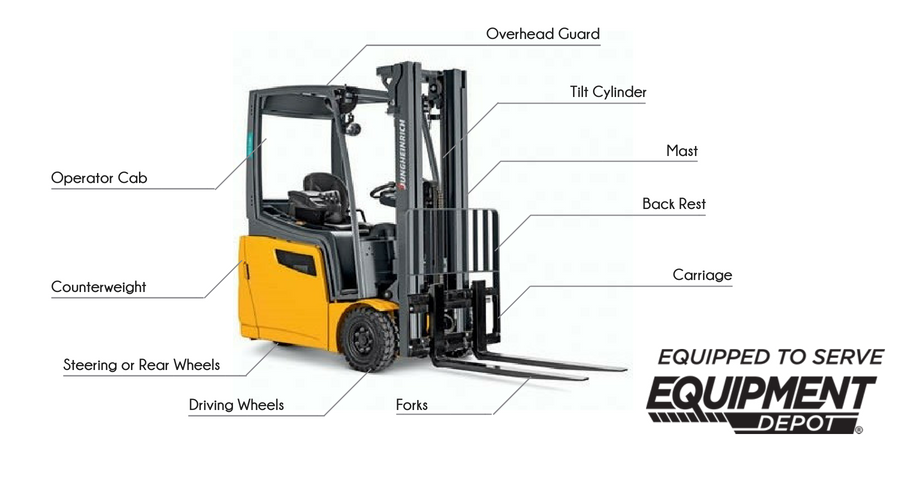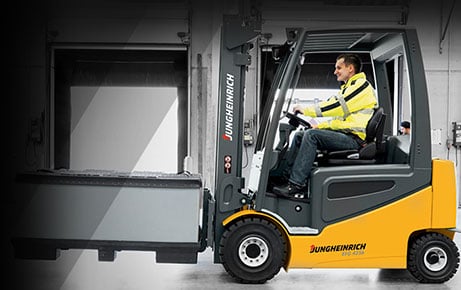
Forklifts have many unique parts that enable the equipment to function properly. Whether you are new to the material handling industry or in need of a refresher on forklifts, keep this blog as a handy guide to forklift features.
First, we’ll start with the exterior, structural features:
- Mast: The mast, sometimes referred to as the ‘upright’, is the vertical support that raises and lowers the load. Hydraulic pistons help move the carriage which is connected to the mast. The mast is located in the front of the forklift and directly in the operator’s line of vision.
- Carriage: The carriage is a support structure where the forks attach or mount. It is a platform in front of the mast used to mount objects to be controlled by the mast. This includes anything that comes in directs contact with the load, including the forks and the back rest.
- Back Rest: The back rest protects the mast cylinder’s hoses and prevents items from falling through the mast and hitting the operator. It is attached to the carriage and prevents the load from shifting backwards.
- Fork: The forks are used to make direct contact with a load for transport. They are attached to the carriage and are designed to carry a load from the bottom. Forks come in all shapes and sizes to accommodate a variety of loads.
- Lift Cylinder: The lift cylinder powers the raising or lowering of the carriage and the forks. The lift cylinder is often hydraulically powered and only pushed in one direction.
- Operator Cab: The space in the lift where the operator sits. This can be enclosed or open depending on the needed application.
- Overhead Guard: The overhead guard is the forklift’s framework or roof. The overhead guard is a critical safety feature because it protects the operator in case something falls onto the cab.
- Tilt Cylinder:The tilt cylinder is similar to the lift cylinder, however it controls the tilt movement of the carriage and the angle of the forks relative to the ground. Simply put, the tilt cylinder controls the amount by which the forklift may tilt beyond the vertical position, forward, or backward.
- Drive Wheels: The drive wheels are typically the wheels located in the front. These are responsible for moving the machine.
- Steering Wheels: The steering wheels are located in the back of the lift and are usually smaller than the drive wheels. They help steer which direction the forklift goes.
- Counter Weight:This is the weight installed onto the equipment to help offset the load. This helps keep the machine stable while lifting and traveling. Forklifts are designed with maximum carrying capacities using the counterweight for balance, so it is important you never exceed that capacity.
- Rating Plate: The rating plate contains information about the maximum load capacity a forklift can carry. Make sure you know your equipment’s load capacity to ensure safe operation.
There are also numerous features you should know inside the operator’s cab:
- Brake Pedal: The lift truck has a conventional brake pedal and an inching brake pedal. The conventional pedal is located on the floor to the right of the steering column.
- Inching Brake Pedal: The inching brake pedal is located on the left side of the steering column and works similar to a clutch pedal. Power disconnects when you lightly step on the pedal. When the pedal is stepped on further, the brake begins to operate.
- Accelerator Pedal: The accelerator pedal is located in a convenient position to the right of the steering column.
- Forward-Reverse Lever: The forward-reverse lever is used to make a directional change. To move forward, push the lever forward. To back up, pull the lever backwards through neutral.
- Gear Shift Lever: This lever permits selection of different gear ratios. The transmission enters the first speed position when the gear shift lever is forward. Select the travel speed as required to meet the travel conditions and load.
- Lift Lever: The Lift Lever is used to lift and lower the forks. Push forward to lower, pull backward to lift. The lifting speed is adjustable by varying the engine speed and the distance the lever is moved. The lowering speed can be adjusted only by the distance the lever is moved.
- Tilt Lever: The tilt lever is used to tilt the mast forward and backward. Push forward to tilt forward, pull backward to tilt backward. The forward or backward tilting speed can be adjusted by the engine speed and the distance that the lever is moved.
Finally, you should be familiar with these common attachments:
- Sideshifters: These allow the forks to move in order to position them appropriately in line with the load. They save time and cut down on wear and tear on the truck by reducing the amount of repositioning the truck will have to do.
- Fork Positioners: Fork positioners allow the forks to move closer together or farther apart hydraulically. This means the operators do not have to manually adjust the fork positioning, which will extend the life of the equipment.
- Carton Clamp: These are helpful when moving large, rectangular boxes that do not need a pallet. Removing pallets decreases costs and shipping rates and increases storage space.
- Single-Double Pallet Handler: If you are moving a large amount of product, a Single-Double Pallet Handler may be perfect for you. This attachment can carry one or two pallets depending on the positioning of its four forks.
- Push/Pull: The Push/Pull attachment is useful when moving material that is on a slip sheet instead of a pallet.
Although every machine varies, these are the most common features. If you need more help choosing which forklift is right for you and your company, call 888.EQDEPOT or contact your local Equipment Depot sales representative.


